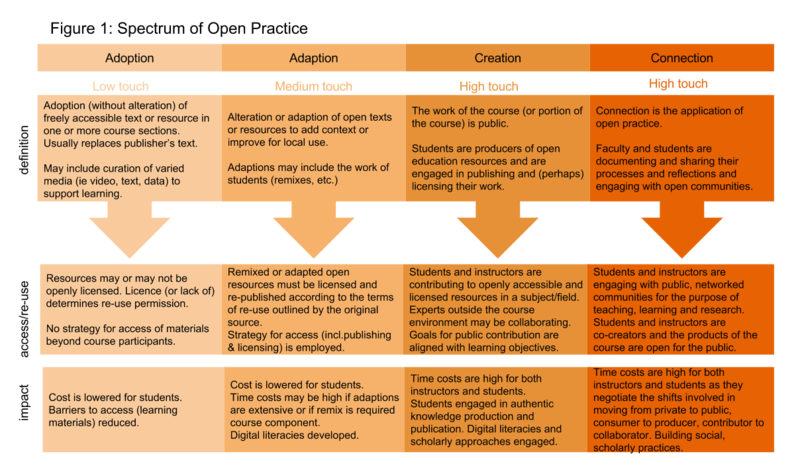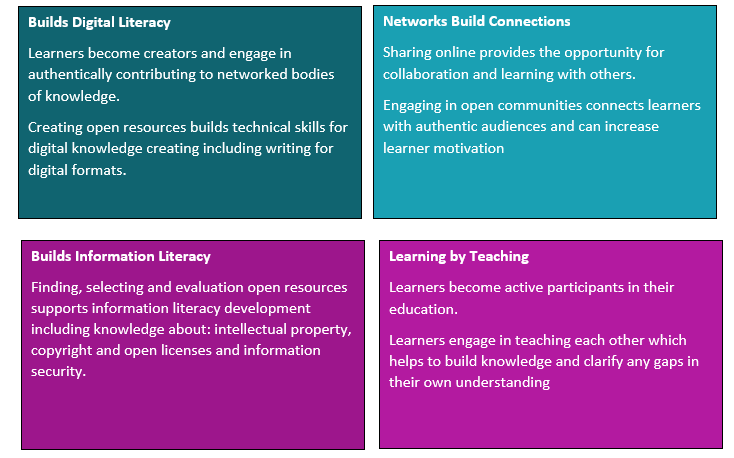Teaching in the Open
Open Education
Open education can trace its roots to the Universal Declaration of Human Rights (UDHR), adopted by the United Nations in 1948, which states “everyone has a right to education.” The 2007 Cape Town Open Education Declaration states that open education and the use of open educational resources (OER) contribute “to making education more accessible, especially where the money for learning materials is scarce. They also nourish the kind of participatory culture of learning, creating, sharing and cooperation that rapidly changing knowledge societies need.” In 2012, the UNESCO Paris OER Declaration [pdf] recommended that governments “promote and use OER to widen access to education at all levels, both formal and non-formal, in a perspective of lifelong learning, thus contributing to social inclusion, gender equity and special-needs education.”
Open education encompasses a set of practices directed at making the process and products of education more transparent, understandable and available to all. Open educational resources are “teaching, learning and research resources that are free of cost and access barriers, and which also carry legal permission for open use. Generally, this reuse permission is granted by use of an open (Creative Commons) licence which allows anyone to freely use, adapt and share the resource — anytime, anywhere.” Open educational resources create accessible learning opportunities on a large scale by eliminating cost barriers to educational resources and providing opportunities to adopt, reuse and adapt resources for sustainable use in classrooms.
The above information is adopted from Open UBC and is licensed under a Creative Commons Attribution 4.0 International License.
Brief History of OER
The open education movement is not new. Terms such as learning objects, open educational resources and digital educational learning materials have been around for the past twenty-plus years. The following timeline provides a brief history of open educational resources. To move through and view the information, hover over the right side of the presentation and then click on the arrow — or expand to full screen.
Throughout this module, we will explore the concept of open education and what that means for faculty, students and the institutions in which we learn and work. We will discuss strategies for implementing open educational resources — as well as examine the pedagogical benefits of integrating an open approach into teaching and learning.
What is Teaching in the Open?
Open UBC suggests that “teaching in the open means that you are making some or all aspects of your learning environment available and accessible to the public.” That said, it is important to note that embracing open isn’t so much about arriving at a particular destination as it is about the journey. Being open can include adopting an open textbook or other learning activity. It may mean contributing to the development of open educational resources in partnership with colleagues or students. For some, it may mean adopting a set of practices or philosophies that focus on open. In the Spectrum of Open Practice (below), Cindy Underhill applies a value of low-, medium- or high-touch to express the degree of interactions — as well as the effort and ongoing support required — for each element of open practice.
As you review the following image of the Spectrum of Open Practice, think about where you are in your open practice.

“Spectrum of open practice” image long description
Table with four columns, each with five rows.
Column 1: Adoption
Row 1: Low touch
Row 2: Definition
Adoption (without alteration) of freely accessible text or resource in one or more course sections. Usually replaces publisher’s text.
May include curation of varied media (ie video, text, data) to support learning.
Row 3: Down arrow
Row 4: Access / re-use
Resources may or may not be openly licensed. Licence (or lack of) determines re-use permission.
No strategy for access of materials beyond course participants.
Row 5: Impact
Cost is lowered for students. Barriers to access (learning materials) reduced.
Column 2: Adaption
Row 1: Medium touch
Row 2: Definition
Alteration or adaption of open texts or resources to add context or improve for local use.
Adaptions may include the work of students (remixes, etc.)
Row 3: Down arrow
Row 4: Access / re-use
Remixed or adapted open resources must be licensed and re-published according to the terms of re-use outlined by the original source.
Strategy for access (including publishing and licensing) is employed.
Row 5: Impact
Cost is lowered for students.
Time costs may be high if adaptions are extensive or if remix is required course component.
Digital literacies developed.
Column 3: Creation
Row 1: High touch
Row 2: Definition
The work of the course (or portion of the course) is public.
Students are producers of open education resources and are engaged in publishing and (perhaps) licensing their work.
Row 3: Down arrow
Row 4: Access / re-use
Students and instructors are contributing to openly accessible and licensed resources in a subject/field. Experts outside the course environment may be collaborating. Goals for public contribution are aligned with learning objectives.
Row 5: Impact
Time costs are high for both instructors and students.
Students engaged in authentic knowledge production and publication. Digital literacies and scholarly approaches engaged.
Column 4: Connection
Row 1: High touch
Row 2: Definition
Connection is the application of open practice.
Faculty and students are documenting and sharing their processes and reflections and engaging with open communities.
Row 3: Down arrow
Row 4: Access / re-use
Students and instructors are engaging with public, networked communities for the purpose of teaching, learning and research. Students and instructors are co-creators and the products of the course are open for the public.
Row 5: Impact
Time costs are high for both instructors and students as they negotiate the shifts involved in moving from private to public, consumer to producer, contributor to collaborator. Building social, scholarly practices.
Below are more details for each stage of the spectrum. Select each section to view additional information.
Why Engage in Open Teaching?
There is no doubt that using open educational resources such as textbooks and other learning activities saves students money. This benefits students in many ways. OER also provide a more level academic playing field — as all students can access course materials on the first day of instruction.
When educators engage in open educational practices (OEP), they have the opportunity to rethink how they provide instruction and/or share knowledge with their students. OER provide flexibility for educators to adapt existing resources to support their specific needs — ensuring that content and materials are relevant and up-to-date.

“Why engage in open teaching” image long description
Four coloured text boxes.
Top left, blue box:
Headline: Builds Digital Literacies
Learners become creators and engaged in authentically contributing to networked bodies of knowledge.
Creating open resources builds technical skills for digital knowledge creation including writing for digital formats.
Top right, gold box:
Headline: Networks Build Connections
Sharing online provides the opportunity for collaboration and learning with others.
Engaging in open communities connects learners with authentic audiences and can increase learner motivation.
Bottom left, gray box:
Headline: Builds Information Literacies
Finding, selecting and evaluating open resources supports information literacy development including knowledge about: intellectual property, copyright and open licenses and information security.
Bottom right, green box:
Headline: Learning by Teaching
Learners become active participants in their education.
Learners engage in teaching each other which helps to build knowledge and clarify any gaps in their own understanding.
Extend Activity
Open education is a personal choice, the same as any other teaching-and-learning model. When shifting our educational philosophies, ideas and/or practices, it is important to consider the “why.”
Think about some of the benefits that engaging open education practices could include for you, your students and your institutions.
Now, brainstorm a list of “What’s in it for me?” from an instructor’s perspective — and add these to the Padlet below.
To add your comments, please double click anywhere on the Padlet below or select the plus (+) icon in the lower right-hand corner of the board. For a more accessible version of this activity, please use the web version of this “What’s in it for me?” Padlet [new tab].

